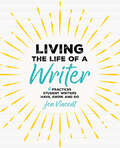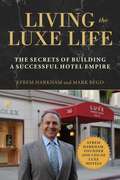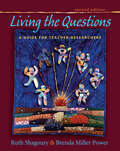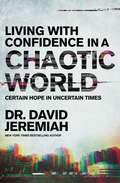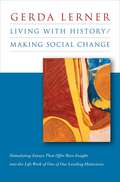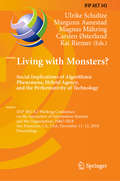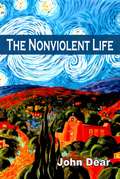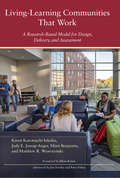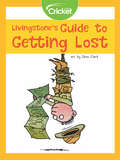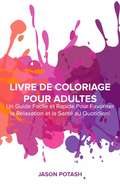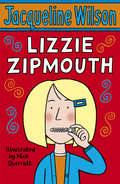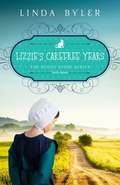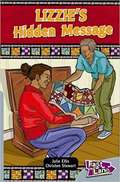- Table View
- List View
Living on Campus: An Architectural History of the American Dormitory
by Carla YanniAn exploration of the architecture of dormitories that exposes deeply held American beliefs about education, youth, and citizenshipEvery fall on move-in day, parents tearfully bid farewell to their beloved sons and daughters at college dormitories: it is an age-old ritual. The residence hall has come to mark the threshold between childhood and adulthood, housing young people during a transformational time in their lives. Whether a Gothic stone pile, a quaint Colonial box, or a concrete slab, the dormitory is decidedly unhomelike, yet it takes center stage in the dramatic arc of many American families. This richly illustrated book examines the architecture of dormitories in the United States from the eighteenth century to 1968, asking fundamental questions: Why have American educators believed for so long that housing students is essential to educating them? And how has architecture validated that idea? Living on Campus is the first architectural history of this critical building type. Grounded in extensive archival research, Carla Yanni&’s study highlights the opinions of architects, professors, and deans, and also includes the voices of students. For centuries, academic leaders in the United States asserted that on-campus living enhanced the moral character of youth; that somewhat dubious claim nonetheless influenced the design and planning of these ubiquitous yet often overlooked campus buildings. Through nuanced architectural analysis and detailed social history, Yanni offers unexpected glimpses into the past: double-loaded corridors (which made surveillance easy but echoed with noise), staircase plans (which prevented roughhousing but offered no communal space), lavish lounges in women&’s halls (intended to civilize male visitors), specially designed upholstered benches for courting couples, mixed-gender saunas for students in the radical 1960s, and lazy rivers for the twenty-first century&’s stressed-out undergraduates. Against the backdrop of sweeping societal changes, communal living endured because it bolstered networking, if not studying. Housing policies often enabled discrimination according to class, race, and gender, despite the fact that deans envisioned the residence hall as a democratic alternative to the elitist fraternity. Yanni focuses on the dormitory as a place of exclusion as much as a site of fellowship, and considers the uncertain future of residence halls in the age of distance learning.
Living the Life of a Writer: 6 Practices Student Writers Have, Know, and Do
by Jen VincentJen Vincent believes everyone is a writer. This conviction has long been her secret to success in classrooms and workshops where she empowers writers of all ages.In Living the Life of a Writer, Vincent shifts the focus of writing instruction from the writing to the writer—guiding teachers so they can help students boldly face the blank page and move through their writing process with enthusiasm.Through a broad lens view, Vincent explores writing instruction as a classroom culture of writing where teachers and students alike approach writing with confidence and curiosity, thinking deeply about the habits they develop and choices they make as writers.Vincent invites readers to reclaim their writer’s workshop by getting back to the essence of what it means to live the life of a writer while exploring the myriad of ways writers live writerly lives. Vincent’s intuitive, inquiry-based approach to writing guides you, and your students, through 6 habits of living the life of a writer:● Writers have a way to collect.● Writers have a writer’s mindset.● Writers know writing is a process.● Writers know strategies to help them write.● Writers explore.● Writers celebrate.As she explores each practice, Vincent shares stories from her classroom, reflections for readers, and ideas that help teachers live the life of a writer alongside their students. Living the Life of a Writer is the guidebook every writing teacher needs to turn writing instruction into a writing lifestyle.
Living the Luxe Life: The Secrets of Building a Successful Hotel Empire
by Mark Bego Efrem HarkhamFor Efrem Harkham, hospitality isn’t just a job—it’s a way of life. And that attitude is evident when you walk into any of Harkham’s one-hundred-plus luxury hotels. In a true, rags-to-riches American success story, Harkham built a renowned international hotel brand that is synonymous with comfort and refinement. Part memoir, part business-success book, Living the Luxe Life is the story of Harkham’s success, detailing the secrets behind his accomplishments. Taking a philosophical approach to business, Harkham describes his commitment towards maintaining excellence in all aspects of his life, succeeding in a constantly evolving marketplace, and mentoring employees. He firmly believes that this method is the best way to provide his customers with a superior product. Additional chapters expand on Harkham’s business model, touching on his belief in the importance of philanthropy, education, and patience in building a strong and successful business. Profound and insightful, Living the Luxe Life is a must have for any reader who aspires to one day succeed in the business world.
Living the Mission
by RenovareLiving the Mission explores what it means to be a Christian today. By examining the early church's struggle in the wake of Jesus's devastating death and awe-inspiring resurrection in the book of Acts, we learn how we can follow Jesus, how Jesus is still with us in the Holy Spirit, and how we are called to form communities into which we are forever inviting others. Conveniently organized for individual or group study, Living the Mission explores the heart of what it means to follow Jesus and be a part of his church.
Living the Questions: A Guide for Teacher-Researchers
by Ruth Shagoury Brenda Miller PowerTeacher research is an extension of good teaching, observing students closely, analyzing their needs, and adjusting the curriculum to fit the needs of all. In this completely updated second edition of their definitive work, Ruth Shagoury and Brenda Miller Power present a framework for teacher research along with an extensive collection of narratives from teachers engaged in the process of designing and carrying out research projects to inform their instruction. This edition includes a greater variety of short contributions from a wide range of teacher-researchers -- novices and veterans from all backgrounds and parts of the country -- who speak to the growing diversity in today' s classrooms. Threaded throughout the chapters and narratives is a discussion of the emergence of digital tools and their effect on both teaching and the research process, along with an expanded number of research designs. The book has three primary components: 1.Chapters written by the authors explaining key elements of the research process: finding questions, designing projects, data collection and analysis, and more 2.Research activities that enable readers to try out the featured strategies and techniques 3.Teacher-researcher essays in which teachers share details of completed projects and discuss the impact they have had in their classrooms. Living the Questions, Second Edition: A Guide for Teacher-Researchers will take you step-by-step through the process of designing, implementing, and publishing your research. Along the way, it will introduce you to dozens of kindred spirits who are finding new passion for teaching by living the questions every day in their classrooms. You will be reminded of why you became a teacher yourself.
Living the Stories We Create: Preparing Students for the Digital Age (SpringerBriefs in Education)
by Ellen McCabeThis work explores the potential of digital media to rectify the disparity between formal learning contexts and contemporary perceptions and expectations of narrative. How can education systems respond to the changing technological landscape, thus preparing students to become active participants in society as well as to realise the extent of their own potential? This book explores such concepts in the classroom environment through direct engagement with students and teachers with the case of Shakespeare's Macbeth. Written in approximately 1606, Macbeth has its roots in a culture of orality and yet has sustained through centuries of print dominance. Indeed, as both text and performance the work itself embodies both the literary and the oral. Yet as a staple of many second level curricula increasingly Macbeth is perceived as an educational text. Macbeth reflects its cultural moment, an age of ambiguity where much like today notions of selfhood, privacy, societal structures, media and economy were being called into question. Thus Macbeth can be understood as a microcosm of the challenges existing in contemporary education in both content and form. This book examines Macbeth as a case-study in seeking to explore the implications of digital media for learning, as well as its possible potential to constructively facilitate in realigning formal learning contexts to contemporary experiences of narrative.
Living with Confidence in a Chaotic World: Certain Hope In Uncertain Times
by Dr. David JeremiahNew York Times bestselling author, Dr. David Jeremiah updates his classic book, Living with Confidence in a Chaotic World, offering biblically based, practical instruction for living a confident life in a world filled with chaos and crisis. &“Let not your heart be troubled . . .&” Confidence can be hard to come by these days. People are losing their jobs, their houses, and their life savings at an unprecedented rate. Violence, natural disasters, and moral depravity seem to be skyrocketing. In the midst of all this chaos, we need to know . . . what on earth should we do now? David Jeremiah brings a message of hope and confidence from the priceless counsel of the Word of God. He answers our most urgent questions, including:How can we weather this storm with a calm heart?What does it truly mean to &“wait on the Lord&”?What is Jesus saying to our chaotic world today?How on earth did we get into this mess?Can we take a broken world and rebuild it into something fruitful?Living with Confidence in a Chaotic World shows us all that with the power and love of Almighty God, we can live with confidence in this age of turmoil.
Living with God's Courage (Jesus Calling Bible Studies)
by Sarah YoungIn Living with God's Courage, the sixth study in the Jesus Calling® Bible Study Series, you will discover how God calls each of His children to not only resist fear but also move through life with courage. God's Word reveals that the Lord is always with you and always willing to empower you with strength from the Holy Spirit. When you walk in God's ways and recognize that He is on your side, it gives the confidence to proclaim to the world, "The Lord is my helper, I will not be afraid. What can mere mortals do to me?" (Hebrews 13:6). Each of the Jesus Calling® Bible studies includes devotional readings from Jesus Calling®, selected passages of Scripture for reflection, Bible study questions, and additional questions to help you apply the material. This study can be used for personal reflection and Bible study or in a small-group setting.
Living with History / Making Social Change
by Gerda LernerThis stimulating collection of essays in an autobiographical framework spans the period from 1963 to the present. It encompasses Gerda Lerner's theoretical writing and her organizational work in transforming the history profession and in establishing Women's History as a mainstream field.Six of the twelve essays are new, written especially for this volume; the others have previously appeared in small journals or were originally presented as talks, and have been revised for this book. Several essays discuss feminist teaching and the problems of interpretation of autobiography and memoir for the reader and the historian. Lerner's reflections on feminism as a worldview, on the meaning of history writing, and on problems of aging lend this book unusual range and depth. Together, the essays illuminate how thought and action connected in Lerner's life, how the life she led before she became an academic affected the questions she addressed as a historian, and how the social and political struggles in which she engaged informed her thinking. Written in lucid, accessible prose, the essays will appeal to the general reader as well as to students at all levels. Living with History / Making Social Change offers rare insight into the life work of one of the leading historians of the United States.
Living with Monsters? Social Implications of Algorithmic Phenomena, Hybrid Agency, and the Performativity of Technology: IFIP WG 8.2 Working Conference on the Interaction of Information Systems and the Organization, IS&O 2018, San Francisco, CA, USA, December 11-12, 2018, Proceedings (IFIP Advances in Information and Communication Technology #543)
by Carsten Østerlund Margunn Aanestad Kai Riemer Ulrike Schultze Magnus MähringThis book constitutes the refereed proceedings of the IFIP WG 8.2 Working Conference on Information Systems and Organizations, IS&O 2018, held in San Francisco, CA, USA, in December 2018.The 11 revised full papers presented together with one short paper and 2 keynote papers were carefully reviewed and selected from 47 submissions. The papers are organized in the following topical sections: setting the stage; social implications of algorithmic phenomena; hybrid agency and the performativity of technology; and living with monsters.
Living with Moral Disagreement: The Enduring Controversy about Affirmative Action
by Michele S. MosesHow to handle affirmative action is one of the most intractable policy problems of our era, touching on controversial issues such as race-consciousness and social justice. Much has been written both for and against affirmative action policies--especially within the realm of educational opportunity. In this book, philosopher Michele S. Moses offers a crucial new pathway for thinking about the debate surrounding educational affirmative action, one that holds up the debate itself as an important emblem of the democratic process. Central to Moses's analysis is the argument that we need to understand disagreements about affirmative action as inherently moral, products of conflicts between deeply held beliefs that shape differing opinions on what justice requires of education policy. As she shows, differing opinions on affirmative action result from different conceptual values, for instance, between being treated equally and being treated as an equal or between seeing race-consciousness as a pernicious political force or as a necessary variable in political equality. As Moses shows, although moral disagreements about race-conscious policies and similar issues are often seen as symptoms of dysfunctional politics, they in fact create rich opportunities for discussions about diversity that nourish democratic thought and life.
Living with an Acquired Brain Injury: The Practical Life Skills Workbook
by Nick Hedley"The Practical Life Skills Workbook" is designed for people who have recovered well enough from brain injury to prepare for a return to independent living. Using a very accessible and easy to read format which takes into account various learning styles resulting from brain injury, the sessions can be completed entirely at the pace that best suits the user. Exercises and tips described in the book cover: Budgeting; Reading and understanding bill terminology; Route orientation; Form filling; and, Planning a night's entertainment. Designed to be completed over a ten week period, this book will represent a milestone in the journey towards living independently for many people, providing careful guidance with everyday tasks and activities that initially appear daunting. It includes downloadable resources of comprehensive, downloadable activities.
Living with the Wolf: Walking the Way of Nonviolence
by Peter EdigerThis collection of poems, reviews, interviews, and short essays is drawn from twenty years of The Wolf, the newsletter of Pace e Bene Nonviolence Service. In a world where violence seems ever more devastating, this book makes the case for a very different way of thought and action. In "A Gradual Awakening," Laura Slattery traces her evolution from Army nurse to active nonviolence. In "Soul Force," Cynthia Stateman describes how a murder victim's family worked to give the killer a chance for a better life.
Living, Learning, and Languaging Across Borders: Students Between the US and Mexico
by Tatyana Kleyn Tim PorterAddressing the roles of education, language, and identity in cyclical migration, this book highlights the voices and experiences of transborder students in Mexico who were born or raised in the US. The stories develop a portrait of the lived realities, joys, and challenges that young people face across elementary, secondary, and tertiary levels. The book not only discusses migration and education policies and pedagogies grounded in the fluid lives of these young people, but its photography also presents their experiences in a visual dimension that words alone cannot capture. This in-depth, multimodal study examines the interplay of language, power, and schooling as they affect students and their families to provide insights for educators to develop meaningful pedagogies that are responsive to students’ border crossing experiences. Living, Learning, and Languaging Across Borders is a vital resource for pre- and in-service teachers, teacher educators, graduate students and scholars in bilingual and multilingual education, literacy and language policy, and immigration and education in the US, Mexico, and beyond. It offers important insights into the complex landscapes transborder students navigate, and considers policy and pedagogy implications that reject problematic assumptions and humanize approaches to the education and migration experiences of transborder students.
Living-Learning Communities That Work: A Research-Based Model for Design, Delivery, and Assessment
by Mimi Benjamin Karen Kurotsuchi Inkelas Jody E. Jessup-Anger Matthew R. WawrzynskiCo-published with In 2007, the American Association of Colleges and Universities named learning communities a high-impact practice because of the potential of these communities to provide coherence to and ultimately improve undergraduate education. Institutional leaders have demonstrated a commitment to providing LLCs, but they currently do so primarily with anecdotal information to guide their work. As a result, there is substantial variation in organizational structure, collaboration, academic and social environments, programmatic integration, student outcomes, and overall quality related to LLC participation. To establish a stronger, more unified basis for designing and delivering effective LLCs, the authors of Living-Learning Communities that Work collaborated on the development of a comprehensive empirical framework for achieving the integrating potential of LLCs. This framework is designed to help practitioners guide the design, delivery, and assessment of LLCs. This book thoughtfully combines research and field-tested practice to document the essential components for best practices in living learning communities and presents them as a clear blueprint – the LLC best practices model – for LLC design. Practitioners, researchers, and institutional leaders can use the book as a guide to more effectively allocate resources to create and sustain LLCs and to realize the potential of these communities to improve undergraduate education.
Living-Learning Communities in Practice: A Guide for Creating, Maintaining, and Sustaining Effective Programs in Higher Education
by Mimi Benjamin Karen Kurotsuchi Inkelas Jody E. Jessup-AngerThis book offers a roadmap for developing, growing, and sustaining living-learning communities (LLCs) that promote student success and enhance the undergraduate experience.Drawing on the Best Practices Model presented in Living-Learning Communities That Work, as well as updated research and rich, real-life examples from LLC administrators, the authors offer a revised and improved model for effective LLC practice. Nuanced typologies guide stakeholders in developing and growing their own programs, from the foundational, to the intermediate, and to the advanced level. This text features an extended section on the assessment of LLCs, complete with a logic model for integrating program assessment with student learning outcomes, and concludes with lessons learned from the COVID-19 pandemic and a look into the future of LLCs in higher education.At a time when colleges and universities struggle to create community for students, this book will be a valuable resource to practitioners, researchers, and institutional leaders to more effectively allocate resources to create and sustain LLCs and to realize the potential of these communities to improve undergraduate education.For more information about ACUHO-I membership, events, and resources, please visit acuho-i.org.
Livingstone's Guide to Getting Lost
by Liz HuyckUsually we want to find our way, but in this cartoon, readers explore all the sure ways of getting lost!
Livre de coloriage pour adultes: Un guide facile et rapide pour favoriser la relaxation et la santé au quotidien !
by Jason PotashVoulez-vous savoir comment maîtriser le coloriage dans votre temps libre et profiter davantage de cette activité de détente ? Maintenant, vous pouvez. Présentation : Livre de coloriage pour adultes : un guide facile et rapide pour favoriser la relaxation et la santé au quotidien ! Dans ce livre, vous découvrirez : 1. Les matériaux les plus populaires pour le coloriage 2. Les différentes techniques de coloriage 3. La théorie de la couleur et comment l’exploiter dans votre coloriage 4. Comment stimuler votre créativité et produire un coloriage brillant 5. Les outils/articles de scrapbooking essentiels pour le coloriage 6. Les outils anciens de méditation avec le coloriage et le dessin – Les neuf modèles connus sous le nom de Yantra 7. Liste d’actions rapides pour commencer votre voyage dans le coloriage 8. Le tableau des couleurs Choisissez ce livre maintenant et commencez votre voyage en couleurs dès aujourd’hui !
Lizards (National Geographic Kids Readers)
by Laura MarshFrom geckos to iguanas, komodo dragons to chameleons, lizards are about the most awesome animal around! They inhabit every continent except Antarctica. Some are lethal. Some change color. Some have suction cups on their feet. There is enough fascinating information about these animals to fill an entire library of readers! But we've taken the absolute coolest information about the coolest animal and compacted it in this fascinating level 2 reader, perfect for anyone who loves slippery, slimy, creepy, and crawly.This high-interest, educationally vetted series of beginning readers features the magnificent images of National Geographic, accompanied by texts written by experienced, skilled children's book authors.The inside back cover of the paperback edition is an interactive feature based upon the book. Level 1 books reinforce the content of the book with a kinesthetic learning activity. In Level 2 books readers complete a Cloze letter, or fun fill-in, with vocabulary words.National Geographic supports K-12 educators with ELA Common Core Resources.Visit www.natgeoed.org/commoncore for more information.
Lizards: Independent Reading Green 5 Non-fiction (Reading Champion #1142)
by Damian HarveyThis story is part of Reading Champion, a series carefully linked to book bands to encourage independent reading skills, developed with Dr Sue Bodman and Glen Franklin of UCL Institute of Education (IOE)Reading Champion offers independent reading books for children to practise and reinforce their developing reading skills.Fantastic, original stories are accompanied by engaging artwork and a reading activity. Each book has been carefully graded so that it can be matched to a child's reading ability, encouraging reading for pleasure.
Lizzie Zipmouth
by Jacqueline WilsonLizzie refuses to speak. She doesn't want to talk to Rory or Jake, her new stepbrothers. Or to Sam, their dad. Or even to her mum. She's completely fed up with having to join a new family, and nothing can convince her to speak to them. Not football, not pizza, not a new bedroom. That is, until she meets Great-Gran - a member of the new family who is even more stubborn than she is . . .
Lizzie and Emma: The Buggy Spoke Series, Book 2 (The Buggy Spoke Series #2)
by Linda BylerIn Little Amish Lizzie, the first book in the Buggy Spoke series, five-year-old Lizzie moves to a new home with her family and must adjust to a new school, new house, and lots of new people. But some things stay the same, including her spunky, sensitive, and mischievous personality. It feels like her big sister Emma is just the opposite—she is sweet, respectful, and good at just about everything that Lizzie isn’t. When Lizzie and Emma begins, Lizzie is eight years old and it’s not that she wishes she weren’t the kind of girl who loves hiding for hours to read a good book or racing down too-steep hills on her sled or eating lots of doughnuts. But she does wish she could make herself walk instead of running once in awhile so she wouldn’t get in trouble at school, and she knows no one thinks she’s as pretty or as good as Emma is. Times are hard for the Glick family—Dat’s business is still not doing well and his cheerful optimism is beginning to wear thin. Lizzie and Emma are young, but they begin to understand that Dat and Mam don’t have enough money and their family might be in trouble. Will the sisters be able to put aside their differences to support each other through their family’s financial struggles, tragedy in their community, and yet more changes? This is the second book in the Buggy Spoke series, which follows Lizzie through her tumultuous teenage years as she struggles to mesh her hot temper and willful ways with her Amish faith. These books are the prequels to Linda Byler’s bestselling Lizzie Searches for Love Trilogy, geared to a younger audience (ages 8-10). Reminiscent of Laura Ingalls Wilder’s Little House series, these books are delightful accounts of another way of life; each chapter is filled with vivid descriptions of Amish food, farms, and traditions. The series explores themes of respecting parents, not fitting in, sibling rivalry, recognizing your own shortcomings and gifts, and reconciling a strong personality with an abiding faith.
Lizzie's Carefree Years: The Buggy Spoke Series, Book 3 (Buggy Spoke Series)
by Linda BylerBestselling Amish novelist Linda Byler’s third book in the Buggy Spoke series for young readersLizzie is nine years old now and adjusting her new home in Jefferson County. There’s so much to get used to—a new school, new friends, new ways of dressing and speaking. Mostly Lizzie loves her new life, but it’s not easy getting used to so many changes at once. Perhaps the hardest part is growing up itself. Suddenly her older sister Emma expects Lizzie to “act her age,” but what does that even mean? Is it wrong to want to splash in slush puddles, play games with friends, and run through the woods? Lizzie wants to be a good girl, but it’s confusing to know when it’s ok to have fun, how she should pray, and why she still does naughty things. Mam and Dat seem to have enough money now—there’s plenty of food and the kids even get extra special Christmas gifts. Mam smiles more and Dat seems more relaxed. But when Lizzie and Emma wake up to a room full of smoke, they realize danger can strike even when things feel the most secure. Will their new community come to their aid after the fire? And why does God allow such scary things to happen? This is the third book in the Buggy Spoke series, which follows Lizzie through her tumultuous teenage years as she struggles to mesh her hot temper and willful ways with her Amish faith. These books are the prequels to Linda Byler’s bestselling Lizzie Searches for Love Trilogy and are geared to a younger audience (ages 8–10). Reminiscent of Laura Ingalls Wilder’s Little House series, these books are delightful accounts of another way of life; each chapter is filled with vivid descriptions of Amish food, farms, and traditions. The series explores themes of respecting parents, not fitting in, sibling rivalry, recognizing your own shortcomings and gifts, and reconciling a strong personality with an abiding faith.
Lizzie's Hidden Message (Into Reading, Level T #44)
by Julie Ellis Christen StewartNIMAC-sourced textbook
Llama Llama Back to School (Llama Llama)
by Anna Dewdney Reed DuncanA Netflix Original seriesWith over 30 million copies in print, Anna Dewdney's New York Times bestselling Llama Llama books have provided hours of comfort and fun-to-read-aloud rhyme.Summer days are getting shorter and it's almost time for the first day of school for Llama! But Llama Llama isn&’t ready for summertime to end. It's been full of backyard camping, family picnics, and ice cream with friends. All he wants is for summer to go on forever! He&’s anxious about his first day back at school but maybe, with some help from his friends and Mama Llama, going back to school will be fun after all!

